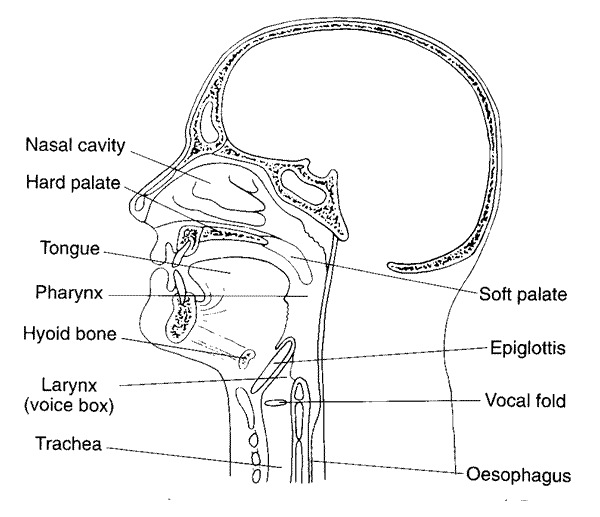
I was just reminded this week of how amazing our ability to produce language is. If you judge by the number of times in your life you have heard the expression „think before you speak!“, you would come to the conclusion that not many people do this. Even fewer, then, think about how they speak before they do, and that is what I would like to bring your attention to this week. Human speech, while astoundingly complex in terms of what it can be used for (proclamations of love, ordering cheeseburgers, or declaring nuclear war), is pretty simple in terms of how it produced.
When you speak, you use your lungs to force air through your vocal tract and out your mouth and nose. Along the way, the air is directed by your uvula, your tongue, and your lips. By controlling just these few pieces of muscle and flesh (I like to call them your „mouth meat“), you are able to produce the entirety of all of the sounds of whichever language you speak. A pretty robust result for so little effort, if you ask me!
The differences between sounds (and through them, meanings of words) are achieved pretty subtly. Try this. Put two fingers on your throat and produce a „p“ and then a „b“ sound. You should notice with the „b“ sound that you feel vibrations, while with the „p“ sound you do not. This is literally the only difference between the production of these two sounds, whether or not you vibrate your vocal cords (known to linguists as „voicing“); everything else with regard to your mouth meat remains exactly the same. These minimal contrasts in articulation exist for all kinds of sounds (you’ll notice the same „voicing“-phenomena for „t“ and „d“ or „k“ and „g“) and they help us understand how humans use our biological features to carve up our speech-production into discrete, differentiable, and recognizable sounds which we can then map meanings onto. (The difference between the meaning of the words „bark“ and „park“ is also created by this simple vibration of the vocal cords.)
All languages need a number of these distinctions in order to create meanings, but not every language contains the same ones. Whereas native English speakers hear a different sounds when they hear „b“ or „v“ because they are sensitive to the contrast in production (how long the sound is „voiced“), native speakers of Spanish would hear both as the same sound. Thus, to a native Spanish speaker, „bat“ and „vat“ would sound like the same word, whereas the difference seems clear as day to a native English speaker. A speaker of Greek is sensitive to two types of „t“ sound, one which includes some extra air release at the end, and one which sounds like the „t“ in English. Wheres this difference in production could be the difference between declaring war and ordering a side of mayonnaise for a Greek speaker, an English speaker would not be sensitive to the difference at all.
If you are interested in which contrastive sounds the English language has, you can read the wikipedia page for English Phonology. During the next week, try to notice where your tongue is and what your vocal cords are doing when you make speak, and next time you tell someone you love them, remember to thank your mouth meat!